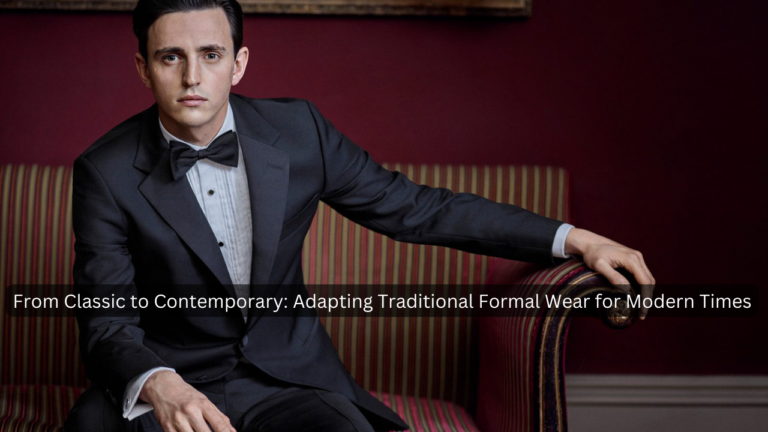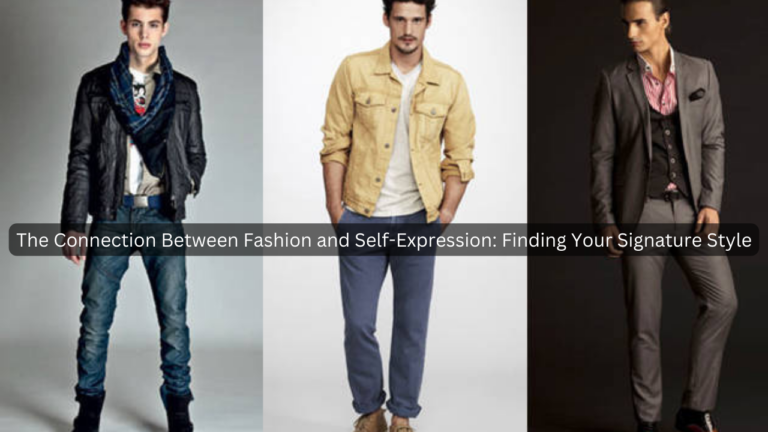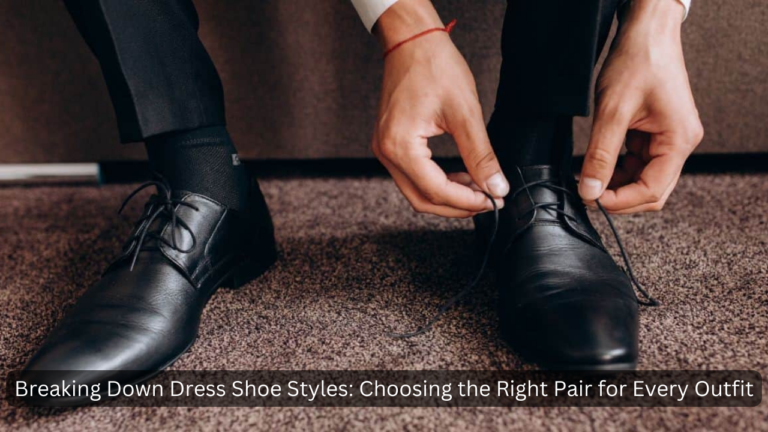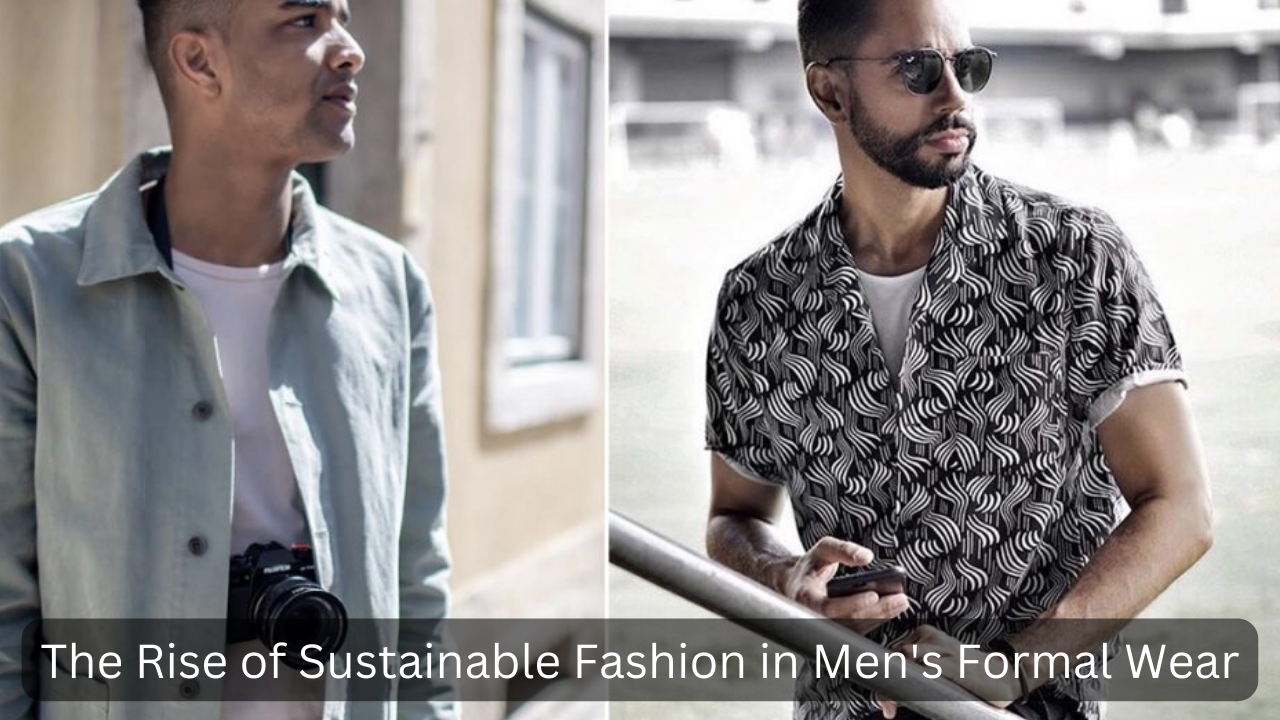
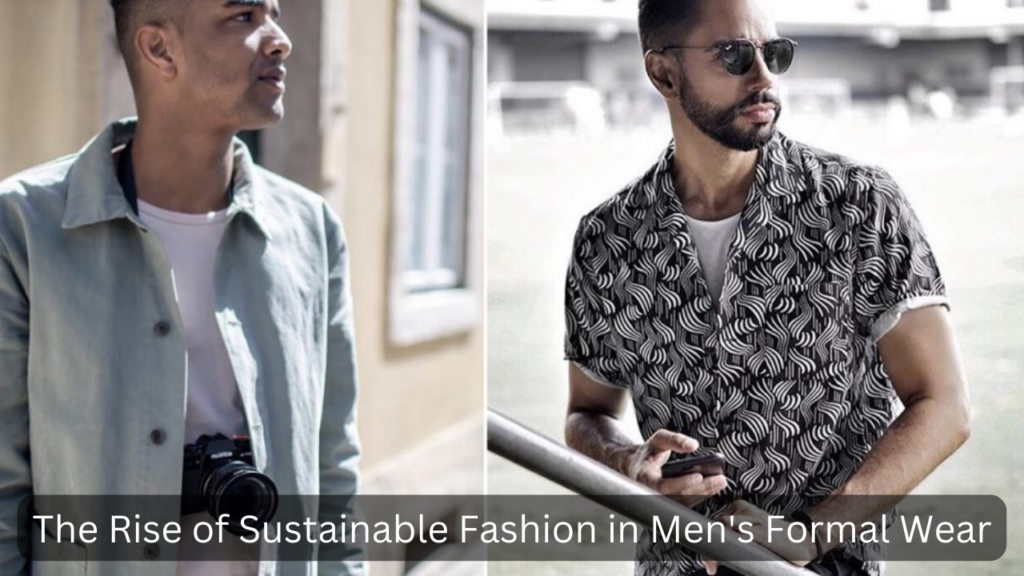
Table of Contents
Introduction
The rise of sustainable fashion in men’s formal wear marks a significant shift in the fashion industry, driven by a growing awareness of environmental and social responsibility. Sustainable fashion refers to clothing that is designed, produced, and used in ways that are environmentally friendly, socially equitable, and economically viable.
In recent years, there has been a notable increase in consumer consciousness regarding the impact of their clothing choices on the planet. This heightened awareness has led to a surge in demand for sustainable alternatives across various fashion segments, including men’s formal wear.
This introduction sets the stage for exploring the key factors contributing to the rise of Sustainable Fashion in Men’s Formal Wear, as well as its impact on the industry and future trends. By delving into the evolution of sustainable practices and their relevance in the realm of formal menswear, we can gain valuable insights into the changing landscape of fashion and the imperative of sustainable practices in the modern era.
Definition of sustainable fashion
Sustainable fashion refers to clothing, accessories, and footwear that are designed, produced, distributed, and used in ways that minimize environmental impact, promote social responsibility, and support economic viability throughout the supply chain. This approach encompasses various practices such as using eco-friendly materials, reducing waste, implementing ethical labor standards, and adopting sustainable manufacturing processes. Sustainable fashion aims to create a more sustainable and equitable fashion industry by considering the environmental, social, and economic implications of every aspect of the fashion lifecycle.
Overview of men’s formal wear industry
The men’s formal wear industry encompasses a range of clothing items designed for formal occasions, such as business meetings, weddings, black-tie events, and professional settings. This includes suits, dress shirts, trousers, blazers, ties, and formal shoes. Traditionally, men‘s formal wear has been associated with classic styles and materials, often made from non-sustainable fabrics such as conventional cotton, polyester, and wool.
However, in recent years, there has been a noticeable shift towards sustainability within the men’s formal wear sector. Brands and designers are increasingly incorporating sustainable practices into their collections, offering eco-friendly alternatives and emphasizing ethical sourcing and production methods. This shift reflects changing consumer preferences and a broader industry movement towards more responsible and conscious fashion choices.
Factors driving the rise of sustainable fashion in men’s formal wear
The increasing prominence of Sustainable Fashion in Men’s Formal Wear can be attributed to several key factors:
Increased Consumer Awareness
Consumers today are more informed about the environmental and social impacts of their purchasing decisions. Issues such as climate change, pollution, and unethical labor practices have become central to public discourse, prompting a demand for more sustainable and ethically produced clothing. Men are increasingly seeking formal wear options that align with their values, prioritizing brands that demonstrate a commitment to sustainability.
Influence of Celebrities and Influencers
Celebrities and social media influencers have a substantial impact on fashion trends. High-profile figures advocating for sustainable fashion choices have helped raise awareness and shift consumer preferences. When influential personal style endorse eco-friendly brands or choose sustainable formal cloths wear for public appearances, it encourages their followers to consider similar choices, driving broader adoption of sustainable fashion.
Industry-Wide Initiatives and Pressure
The fashion industry faces mounting pressure from various stakeholders, including consumers, non-governmental organizations, and regulatory bodies, to adopt more sustainable practices. Industry-wide initiatives such as the Sustainable Apparel Coalition and the Fashion Pact have been established to address environmental and social issues within the fashion sector. These initiatives encourage brands to set and achieve sustainability goals, leading to an increase in the availability of sustainable men’s formal wear options.
Corporate Social Responsibility (CSR) and Brand Image
Brands are increasingly recognizing the importance of corporate social responsibility (CSR) in building a positive brand image and fostering custom tailoring loyalty. Companies that adopt sustainable practices and transparently communicate their efforts to consumers can differentiate themselves in a competitive market. By incorporating sustainability into their business models, formal wear brands can appeal to a growing segment of environmentally and socially conscious consumers.
Technological Advancements and Innovation
Advances in technology and innovation have made it easier for brands to incorporate sustainable practices into their production processes. Developments in sustainable materials, such as recycled fabrics and organic fibers, along with improvements in manufacturing technologies that reduce waste and energy consumption, have enabled the production of high-quality sustainable formal wear. These advancements have made sustainable options more accessible and affordable for consumers.
These factors collectively contribute to the rising trend of Sustainable Fashion in Men’s Formal Wear reflecting a broader movement towards more responsible and ethical fashion consumption.
Increased Consumer Awareness
In recent years, consumers have become significantly more aware of the environmental and social impacts of their purchasing decisions. This heightened awareness is fueled by extensive media coverage on issues such as climate change, pollution, and unethical labor practices in the fashion industry. Documentaries, articles, and social media campaigns have educated the public on the detrimental effects of fast fashion and the benefits of sustainable alternatives. As a result, consumers are increasingly prioritizing sustainability in their buying choices, seeking out eco-friendly and ethically produced formal wear. This shift in consumer behavior is a major driving force behind the rise of Sustainable Fashion in Men’s Formal Wear as people demand more transparency and accountability from brands.
Influence of Celebrities and Influencers
Celebrities and social media influencers play a crucial role in shaping fashion trends and consumer preferences. High-profile figures who advocate for sustainability and showcase their commitment through their fashion choices have a significant impact on their followers. When celebrities choose to wear sustainable formal wear for public appearances, red carpet events, or even in everyday life, it sends a powerful message to their audience. This endorsement can lead to a ripple effect, encouraging more people to consider sustainable options. Influencers, with their vast reach and engaged followers, amplify this effect by regularly promoting sustainable brands and educating their audiences on the importance of ethical fashion practices. The influence of these public figures helps to normalize sustainable fashion and drive its adoption in the men’s formal wear market.
Industry-Wide Initiatives and Pressure
The fashion industry is experiencing increasing pressure to adopt sustainable practices from various stakeholders, including consumers, non-governmental organizations, and regulatory bodies. This pressure has led to the establishment of several industry-wide initiatives aimed at promoting sustainability. For instance, the Sustainable Apparel Coalition and the Fashion Pact are collaborative efforts among brands, retailers, and manufacturers to address environmental and social issues within the industry. These initiatives encourage the adoption of sustainable materials, waste reduction techniques, and fair labor practices. Additionally, regulatory pressures, such as stricter environmental laws and labor regulations, compel brands to enhance their sustainability efforts. The collective impact of these initiatives and pressures is driving significant changes in the men’s formal wear sector, leading to increased availability and adoption of sustainable fashion options.
Key Components of Sustainable Fashion in Men’s Formal Wear
Eco-Friendly Materials
A fundamental aspect of sustainable fashion is the use of eco-friendly materials. In men’s formal wear, this includes fabrics that have a lower environmental impact throughout their lifecycle. Examples include organic cotton, which is grown without harmful pesticides and synthetic fertilizers, and recycled polyester, which reduces waste and the demand for virgin materials. Sustainable wool, often sourced from farms practicing regenerative agriculture, is another popular choice. Additionally, innovative materials like Tencel, made from sustainably sourced wood pulp, are becoming more prevalent. These materials are not only environmentally friendly but also offer comfort and durability, making them ideal for formal wear.
Ethical Manufacturing Practices
Ethical manufacturing is crucial to sustainable fashion, ensuring that clothing is produced in ways that respect both people and the planet. This involves fair labor practices, including safe working conditions, fair wages, and no child or forced labor. Transitioning in the supply chain is essential, allowing consumers to understand where and how their garments are made. Many sustainable brands also focus on reducing their carbon footprint by using renewable energy sources, minimizing water usage, and employing less polluting dyeing processes. By adhering to these ethical standards, brands contribute to a more equitable and sustainable fashion industry.
Reduction of Waste
Minimizing waste is a key principle of sustainable fashion. In the context of men’s formal wear, this can be achieved through several strategies. Zero-waste pattern making, which involves designing garments in a way that eliminates fabric scraps, is one approach. Another is upcycling, where existing materials or garments are repurposed into new products. Brands are also adopting circular fashion principles, designing products with their end-of-life in mind to facilitate recycling or composting. Additionally, high-quality, durable designs extend the life of garments, reducing the need for frequent replacements. By focusing on waste reduction, the men’s formal wear industry can significantly lessen its environmental impact.
Impact of Sustainable Fashion on the Men’s Formal Wear Market
Growth in Sustainable Menswear Brands
The rise of sustainable fashion has led to a significant increase in the number of brands specializing in eco-friendly and ethically produced men’s formal wear. These brands are carving out a niche in the market by offering high-quality, stylish, and sustainable alternatives to traditional formal wear. Established brands are also expanding their collections to include sustainable options, recognizing the growing consumer demand. This diversification is fostering a more competitive market, encouraging innovation and driving overall industry growth.
Changes in Consumer Preferences
As awareness of environmental and social issues continues to rise, consumer preferences are shifting towards more sustainable options. Modern consumers, particularly younger generations, prioritize brands that align with their values. This shift is evident in the men’s formal wear market, where customers are increasingly seeking out garments made from eco-friendly materials and produced under ethical conditions. This change in consumer behavior is compelling brands to adopt sustainable practices and transparently communicate their efforts to attract and retain customers.
Influence on Industry Standards and Practices
The growing demand for sustainable fashion is influencing industry standards and practices across the men’s formal wear sector. Brands are adopting more rigorous sustainability criteria, leading to improvements in material sourcing, production processes, and waste management. Industry-wide certifications and standards, such as Global Organic Textile Standard (GOTS) and Fair Trade certification, are becoming more prevalent, providing consumers with assurance of a brand’s commitment to sustainability. This shift is also encouraging innovation, with new technologies and methods being developed to enhance sustainability in formal wear production.
Enhanced Brand Reputation and Loyalty
Brands that embrace sustainable practices often enjoy enhanced reputations and stronger customer loyalty. Consumers are increasingly loyal to brands that demonstrate genuine commitment to sustainability and ethical practices. By incorporating sustainable materials and ethical manufacturing processes, brands can differentiate themselves in a crowded market and build a positive brand image. This reputation can lead to increased customer satisfaction, repeat business, and positive word-of-mouth, further driving the growth of Sustainable Fashion in Men’s Formal Wear.
Economic and Environmental Benefits
The adoption of sustainable practices in men’s formal wear offers significant economic and environmental benefits. Economically, brands can reduce costs in the long term by optimizing resource use, reducing waste, and improving supply chain efficiency. Environmentally, sustainable practices help reduce carbon emissions, conserve water, and minimize pollution, contributing to the overall health of the planet. By investing in sustainability, the men’s formal wear market can achieve a more balanced and sustainable growth trajectory, benefiting both businesses and the environment.
Cost Considerations
Challenges:
- Higher Production Costs: Sustainable materials and ethical manufacturing practices often come with higher costs compared to conventional methods. This can result in higher retail prices, making it difficult for some consumers to afford sustainable formal wear.
- Economies of Scale: Smaller sustainable brands may struggle to achieve economies of scale, leading to higher per-unit costs. This can make it challenging to compete with larger, established brands that produce in bulk.
Opportunities:
- Long-Term Savings: Investing in sustainable practices can lead to long-term savings through more efficient use of resources and reduced waste. Brands can also appeal to consumers willing to pay a premium for high-quality, sustainable products.
- Growing Market Segment: As consumer demand for sustainable fashion increases, there is a growing market segment willing to invest in eco-friendly and ethically produced formal wear, providing opportunities for brands to capture this market.
Supply Chain Complexities
Challenges:
- Traceability and Transparency: Ensuring a fully transparent and traceable supply chain can be difficult, particularly for smaller brands with limited resources. Sourcing sustainable materials and verifying ethical practices across the supply chain requires substantial effort and investment.
- Limited Availability of Sustainable Materials: The availability of sustainable materials can be limited, making it challenging for brands to source sufficient quantities to meet demand.
Opportunities:
- Collaboration and Partnerships: Brands can collaborate with suppliers, industry groups, and other stakeholders to improve supply chain transparency and access to sustainable materials. Partnerships can lead to shared resources and knowledge, enhancing overall sustainability efforts.
- Technological Innovations: Advances in technology can streamline supply chain management and improve traceability. Digital tools and blockchain technology can help brands ensure the authenticity and sustainability of their materials and processes.
Innovation and Technology Advancements
Challenges:
- Investment in Research and Development: Developing new sustainable materials and technologies requires significant investment in research and development, which can be a barrier for smaller brands.
- Adoption and Implementation: Integrating new technologies into existing production processes can be complex and time-consuming. Brands may face challenges in adopting and implementing innovative solutions.
Opportunities:
- Advancements in Sustainable Materials: Continuous research and development are leading to the creation of new sustainable materials that offer improved performance and lower environmental impact. Brands that invest in these innovations can differentiate themselves in the market.
- Efficiency Gains: Technological advancements can lead to more efficient production processes, reducing waste and energy consumption. This not only benefits the environment but also lowers production costs in the long run.
Consumer Education and Engagement
Challenges:
- Awareness and Understanding: Despite growing interest in sustainability, some consumers may lack awareness or understanding of what constitutes sustainable fashion. Misconceptions and greenwashing can also confuse consumers.
- Changing Consumer Habits: Encouraging consumers to shift from fast fashion to sustainable options requires significant effort in education and awareness-building.
Opportunities:
- Educational Campaigns: Brands can invest in educational campaigns to raise awareness about the importance of sustainable fashion and the fits of sustainable men’s formal wear. Transparency and storytelling can build trust and engage consumers.
- Consumer Empowerment: Providing clear, accessible information about the sustainability of products empowers consumers to make informed decisions. Brands that prioritize transparency and authenticity can build stronger relationships with their customers.
By navigating these challenges and leveraging opportunities, the men’s formal wear industry can continue to progress towards greater sustainability, meeting the demands of conscious consumers and contributing to a more sustainable future.
Future Outlook and Trends in Sustainable Men’s Formal Wear
Continued Growth of Sustainable Menswear Market
The market for sustainable men’s formal wear is expected to continue growing as awareness of environmental and social issues deepens. This growth will be driven by:
- Increased Consumer Demand: As more consumers prioritize sustainability, the demand for eco-friendly and ethically produced formal wear will rise. This trend will encourage more brands to adopt sustainable practices and expand their sustainable product lines.
- Expansion of Sustainable Brands: New and existing brands will continue to enter and expand in the sustainable menswear market, offering a broader range of styles, materials, and price points. This will provide consumers with more choices and further stimulate market growth.
Evolution of Sustainability Standards
The evolution of sustainability standards will play a crucial role in shaping the future of men’s formal wear. Key trends include:
- Stricter Regulations: Governments and regulatory bodies are likely to implement stricter environmental and labor regulations, pushing brands to adopt more sustainable practices. Compliance with these standards will become a baseline requirement for market participation.
- Enhanced Certifications: Sustainability certifications and labels will become more prevalent and rigorous, providing consumers with greater assurance of a brand’s commitment to sustainable practices. Brands that achieve these certifications will gain a competitive edge.
Integration of Technology in Sustainable Practices
Technological advancements will continue to drive innovation and efficiency in sustainable men’s formal wear. Key developments include:
- Blockchain and Supply Chain Transparency: Blockchain technology will enhance supply chain transparency, allowing brands and consumers to trace the origins and sustainability of materials. This technology will help build trust and accountability in the industry.
- 3D Printing and Customization: 3D printing technology will enable on-demand production and customization of formal wear, reducing waste and inventory costs. This approach will also allow for more personalized and unique garments.
- Sustainable Textile Innovations: Ongoing research and development will lead to new sustainable textiles with improved properties, such as durability, comfort, and performance. These innovations will expand the range of materials available for formal wear.
Circular Fashion Economy
The concept of a circular fashion economy will gain traction, influencing the design and production of men’s formal wear. Key aspects include:
- Recycling and Upcycling: Brands will increasingly adopt recycling and upcycling practices to minimize waste and extend the lifecycle of garments. This will involve designing products for easy disassembly and repurposing.
- Take-Back and Resale Programs: Brands will implement take-back programs to collect and recycle old garments, as well as resale programs to offer pre-owned formal wear. These initiatives will reduce waste and provide more affordable sustainable options.
Increased Collaboration and Industry Partnerships
Collaboration among brands, suppliers, industry groups, and other stakeholders will be essential to advancing sustainability in men’s formal wear. Key trends include:
- Shared Resources and Knowledge: Industry partnerships will facilitate the sharing of resources, knowledge, and best practices, accelerating the adoption of sustainable practices across the sector.
- Collective Action: Collaborative initiatives, such as industry-wide commitments and coalitions, will drive systemic change and set higher standards for sustainability. These efforts will help create a more unified and impactful approach to sustainability in men’s formal wear.
By embracing these future trends and opportunities, the men’s formal wear industry can continue to evolve towards greater sustainability, meeting the demands of conscious consumers and contributing to a more sustainable future.
Conclusion
The rise of Sustainable Fashion in Men’s Formal Wear signifies a transformative shift in the fashion industry. Driven by increased consumer awareness, the influence of celebrities and influencers, and industry-wide initiatives, sustainable practices are becoming integral to the formal wear market. The incorporation of eco-friendly materials, ethical manufacturing practices, and waste reduction strategies are reshaping how men’s formal wear is designed and produced.
The impact of this shift is profound. The market is seeing a growth in sustainable menswear brands, changes in consumer preferences, and an influence on industry standards and practices. Challenges such as higher production costs, supply chain complexities, and the need for continuous innovation are being met with opportunities for long-term savings, technological advancements, and increased consumer engagement.
Looking ahead, the future of sustainable men’s formal wear is promising. Continued growth in the market, evolving sustainability standards, technological integration, and a move towards a circular fashion economy will further entrench sustainability in the industry. Collaboration and industry partnerships will play a crucial role in driving these changes, ensuring that sustainable practices become the norm rather than the exception.
In conclusion, the rise of sustainable fashion in men’s formal wear is more than a trend; it is a critical evolution towards a more responsible, ethical, and environmentally conscious fashion industry. As brands and consumers continue to embrace sustainable practices, the formal wear market will not only thrive but also contribute significantly to the broader goal of sustainability in fashion.
Recap of Key Points
The rise of sustainable fashion in men’s formal wear has been driven by several factors, including increased consumer awareness, the influence of celebrities and influencers, and industry-wide initiatives. Key components of sustainable fashion in this context include the use of eco-friendly materials, ethical manufacturing practices, and waste reduction strategies. These developments have had a significant impact on the market, leading to the growth of sustainable menswear brands, changes in consumer preferences, and an influence on industry standards.
Importance of Sustainable Fashion in Men’s Formal Wear
Sustainable fashion in men’s formal wear is of paramount importance for several reasons. Firstly, it addresses pressing environmental concerns by reducing the industry’s carbon footprint, conserving resources, and minimizing waste. Secondly, it promotes ethical labor practices, ensuring fair wages, safe working conditions, and the absence of child labor in garment production. Thirdly, it meets the growing demand from consumers who prioritize sustainability and ethical values in their purchasing decisions. Overall, sustainable fashion in men’s formal wear aligns with the broader goal of creating a more sustainable and responsible fashion industry.
Call to Action for Consumers and Industry Stakeholders
As consumers, it is essential to continue supporting sustainable fashion in men’s formal wear by making conscious purchasing decisions. This includes choosing brands that prioritize sustainability, educating ourselves about sustainable practices, and advocating for transparency and accountability in the fashion industry. Additionally, engaging with industry stakeholders such as brands, retailers, and policymakers can drive systemic change and encourage the adoption of sustainable practices on a larger scale.
For industry stakeholders, the call to action involves embracing sustainability as a core value and integrating it into every aspect of the business. This includes sourcing eco-friendly materials, implementing ethical manufacturing practices, reducing waste, and engaging with consumers to promote awareness and education. Collaborating with partners and industry peers can also foster innovation and collective action towards a more sustainable future for men’s formal wear.
Together, through collective efforts and a commitment to sustainability, we can shape a fashion industry that not only looks good but also does good for the planet and its people.
